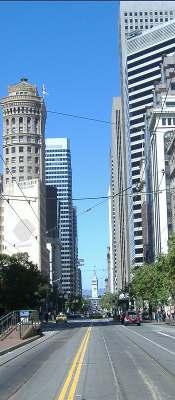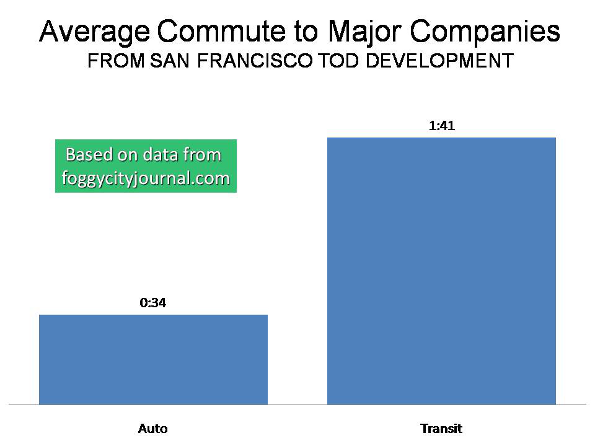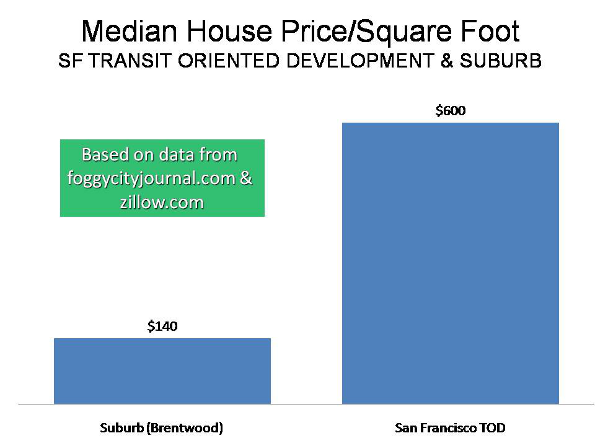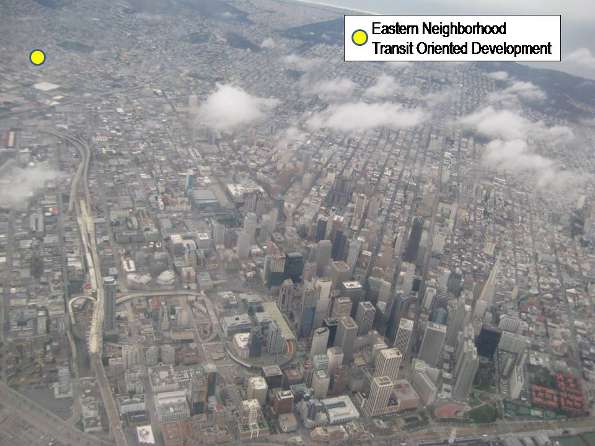
“The Great Transit Oriented Development Swindle?” reads the headline in the Fog City Journal, one of the growing number of internet newspapers providing serious, professional web-based journalism as an alternative to declining print newspapers (and their often less than effective web sites).
The article does not directly answer the question in the headline, but certainly provides enough ammunition to what has become a commonly accepted mantra among planners and urban boosters. It reveals how transit oriented development (TOD) is often based upon fragile foundations that amount to an ideological swindle. It is important to recognize that the Fog City Journal is no right wing or libertarian organ. There is little market for that in the city of San Francisco. The leftish bent of the Fog City Journal, combined with author Marc Salomon’s unusually incisive (and footnoted) analysis makes this article noteworthy. It also seems clear that the author is a proponent of more transit service and funding, not less – even though he is highly skeptical about the current TOD craze.
Transit Oriented Development: The idea behind transit oriented development is that, in new, higher density developments, people use transit more and cars less. Transit oriented development has become a first principle of some, who seem to believe that cities can become vibrant in part by strangling new suburbs out of existence. Transit oriented development is at the very heart of the Obama Administration’s “livability agenda,” and is frequently cited admiringly by Secretary of Transportation Ray LaHood.
Eastern Neighborhoods: Salomon’s subject is San Francisco’s Eastern Neighborhoods, where transit oriented development is proposed. From the beginning Salomon identifies a fundamental problem: “Transit Oriented Development is predicated upon the notion that existing transit infrastructure is attractive enough such that residents of new units will take transit to work instead of drive. He continues: “The existing transit system, both regional and local, is not capable of handling existing demand.”
Salomon correctly notes that “San Francisco is not the regional employment center.” In fact, nearly 90% of employment in the San Francisco-San Jose area is not in downtown San Francisco. Indeed, Silicon Valley, not downtown San Francisco, has long been the largest employment center in the area and there are also major job concentrations in the suburban belt east of Oakland.
No Better Place for Transit Oriented Development: Yet, there are few places in the world better served by transit than the Eastern Neighborhood transit oriented development. The project is no more than a long walk from downtown San Francisco (Figure 1). Residents will be able to access frequent “Muni” bus services. The development would be well served by BART (the regional metro), midway between two stations, both of which access four routes. There are few places in the world where a non-transfer station serves that many routes. Salomon analyzes transit from the center of the development, the corner of Mission and 20th Streets.

Transit Oriented Development: Forcing Longer Commutes: Salomon’s concern starts with the recognition that these systems are already overcrowded. However there is more. Even with their heavy (and highly subsidized) loads, the virtually unparalleled level of transit service available from Mission and 20th cannot compete with the automobile. Salomon’s analysis shows that, on average, transit oriented development residents working at jobs at the 30 largest firms in the San Francisco Bay area would spend nearly 3.5 as much time traveling to work by transit than if they drove themselves. The best transit travel time would be more than double the auto travel time, while the worst would near five times (Figure 2).

Transit Oriented Development: Making Traffic Congestion Worse: Mirroring the research on the association between higher densities and greater traffic congestion, Salomon suggests that without substantial additional transit spending, transit oriented development “in San Francisco will most likely diminish transit reliability by increasing auto trips–the precise opposite of transit oriented development’s stated goals.” On this point, however, it is well to remember that no transit system has ever been seriously conceived, much less proposed or implemented that could provide competitive mobility between Mission and 20th and the dispersed employment throughout the San Francisco Bay Area. A transit system that reaches all of the dispersed employment in a modern American or European urban area at travel times competitive with the car could require annual expenditures that approach or even exceed the gross domestic product of the area.
Unaffordable Transit Oriented Development: But Salomon is not through. Insufficient transit service is only part of the problem. There is a fundamental problem with the thesis that “cities need to densify their urban cores to support greater densities of development.” But, he says, “this is predicated upon the assumption that housing in the urban core and periphery are fungible, that the core and periphery compete interchangeably for buyers.”
Unlike most urban advocates and the Secretary of Transportation, it is apparent that Salomon understands the first principle of “livability.” Livability requires affordability. In San Francisco suburb of Brentwood, for example, Salomon notes that the median house price is $298,000. Brentwood is located in eastern Contra Costa County, approximately 50 miles from downtown San Francisco. But there is no need to travel that far, since there is an abundance of jobs much closer.
This compares to a median price of $627,000 for an apartment/condominium near the proposed transit oriented development in San Francisco. Further, the house in Brentwood will be more than double the size of condo in the transit oriented development, as data from zillow.com indicates. Thus, the new home buyer will pay less than one-fourth the cost per square foot in Brentwood compared to the transit oriented development (Figure 3). The Brentwood household will also enjoy a backyard that would not come with a 23rd floor flat.

Lifestyles of the Few: None of this is to suggest that transit oriented development cannot be attractive. The mistake, however, is the outsized enthusiasm of its proponents. Like a Mini Cooper or sportscar, transit oriented development serves the needs and wants of a narrow niche market, but by no means anything close to the majority.
Salomon concludes:
In order for transit oriented development to check sprawl, prospective home buyers would be expected to make the choice between purchasing a $300K unit in Brentwood or a unit costing twice that much in San Francisco. Further, in order to check motor vehicle commutes, the assumption would be that someone paying that urban location premium would more than double their commute time by taking transit.
Simply stated, many of the claims of transit oriented development proponents simply do not “pencil out.” TOD residents will have to drive, unless their jobs are within walking distance. Further, in the dynamic economy that has developed in US urban areas, few can assume that they will always work in the same place. Most importantly, however, very few suburbanites could afford the tony TODs. That’s not a problem, however, since most of them are probably not sorely tempted.
Photograph: Market Street Toward the Ferry Building, San Francisco
Wendell Cox is a Visiting Professor, Conservatoire National des Arts et Metiers, Paris. He was born in Los Angeles and was appointed to three terms on the Los Angeles County Transportation Commission by Mayor Tom Bradley. He is the author of "War on the Dream: How Anti-Sprawl Policy Threatens the Quality of Life.”













Nailed it.
Well done, Marc. You nailed it here, and seemingly with Cox's endorsement.
However, I'd like to emphasize one of your important points:
"There are many other metrics for quality of life than the tract home and possessions: such as health, good food, retirement, education, transportation security, a healthy ecology, reliable fulfilling employment and free time."
This is why Cox gets it so horribly wrong when he goes out and proclaims "affordability as the first principle of livability."
Now how Cox got the monopoly on defining livability I don't know, but it's clear he's way off the mark with this constant mantra (though I feel he must think it's real clever or self-evident or something - I tend to disagree). Affordability is certainly very important, and I don't know anyone on the environmentalist side that would disagree with that.
But the paths to affordability are many, and how affordability is actually defined is by no means objective (ie. Affordable in terms of what?? Accessibility? Cheapness? Social benefits? I mean, all these concepts imply their own entire urban systems - few of them are suburbia.) Pretending "housing cost" is the only metric by which a space can be considered "affordable" is just insane; every living space comes with a different cost-benefit equation. And furthermore, not everything "livable" can be defined in a cost-benefit equation, as "livable" entails more ideas that mere economics.
Cox needs to introduce more long-term time horizons into his analysis; he needs to broaden his perspective so that it addresses the larger societal context within which economic costs play out. It's not that he's "straight-up" wrong about what he's saying. He isn't. It's that he's thinking in a vacuum, about what's going on today and not tomorrow, about what transport and energy inefficiencies are costing the individual right now, and not what they'll cost the individual over the long run. Nor does he seems to consider how those inefficiencies are constantly shared among individuals in various ways - and how shared costs, in turn, frame the affordability question.
I guess where I'm going with is that most Americans can barely afford car-dependency and the massive cost of infrastructure to support it. This lack of affordability hardly ever seems to bother Cox. Nor does the fact that non-TOD built environments force children, the disabled and elderly to pay a whole other person to essentially chauffeur them around. I mean, if access is really his problem, he has to somehow confront this for his argument to make any sense.
This is where his argument seems to downcycle from "egalitarian-minded housing populist" into "suburb developer puppet sophistry." When you take not only what a person pays for housing, but also in taxes to support that housing and so on, and if one is actually shooting for a society where the carrying costs are cheaper for the average person, then one of the last ideas they should be endorsing is some kind of sprawling, zoned and socialized urbanism like Cox's.
entitlement of profits trumps affordability which is key
San Francisco is more expensive because demand for housing here is driven by very high wage earners from Silicon Valley and from foreign capital purchasing pieds a terre in a "world class" city. (I always reach for my planning revolver whenever I hear terms like "world class" or "vibrant" bandied about by those who refer to residents as NIMBYs)
San Francisco has 800K residents, the total Bay Area, more than 6m. Most Bay Area residents live outside the three major cities, SF, Oakland (330K) and San Jose (1.1m), and perhaps 40% live outside the first ring of suburbs. SF is less desirable by more Bay Aryans than the suburbs by the numbers voting with their commutes.
The "free" real estate market, cheap mortgage capital and corrupt land use policies are tearing San Francisco asunder, taking what had been one of the few continuously successful urban communities of its kind, The Mission District, and imposing inappropriate development on it which is upsetting that natural balance.
The Pelosi Democrats are also aghast that there is a participatory, progressive political project where community folks successfully contend for public office against the corporate hacks and feels that they can build and displace out the threat to corporate Democrat dominance.
San Francisco has substantial pent up housing demand that the market is not realizing, because it is not profitable for the for-profit housing market to do so. It should be the job of the planning department to negotiate a fair deal on behalf of taxpayer to steer development to that which meets our needs for stable development if the entitlements to build here are that desirable.
When the Mayor's office is in the pockets of developers, the City negotiates like its a business alright, a business in the business of making development more profitable. Newsom running for Lt. Governor now takes contributions from developers and is working overtime to stave off the pathetically small level of development fees to provide an "economic stimulus."
The free market does not subsidize public transit. To the contrary, the free market refuses to pay its share of the cost of providing transit (health care, infrastructure, military, you name it, business fights paying it) and in its conduct of its business would just as easily overburden transit to the point of uselessness.
If the so-called free market of hidden subsidies that socializes risk and privatizes profit were allowed to work its will unimpeded, a burger at a median SF restaurant would run you $25 to cover the costs of importing low paid labor from afar or paying locals to do shit work.
You all seriously underestimate what it takes for a successful mixed use neighborhood to evolve and the inability of land use controls to deliver desired outcomes.
I'm a Green who acknowledges the bogosity of the claims of those with whom I otherwise agree on policy. Why are the conservatives so afraid to acknowledge that the world is complex enough that their ideology might not adequately describe what's going on?
The free marketeers had their shot with Greenspan, disciple of Ayn Rand, the Stalin of libertarian Capitalism--one foreclosure is a tragedy, tens of millions, a stastic. At this point, if you are arguing for "free markets," you're arguing for the authoritarian corporate welfare state that is evolving, because the rule of money always leads to that outcome.
-marc
If supply and demand were
If supply and demand were the only forces governing housing prices, then housing prices would have fallen throughout the 2000s, until housing construction finally fell below the rate of household creation in 2008 or 2009. joey atlas
You just earned my subscription to your blog.
Haha, while I might not totally agree with everything you're saying, I definitely see where you're coming from. And where I disagree, I feel like it's because I need to know more about the issue you're referring to. When I disagree with Cox, by contrast, I usually walk away feeling like I'd have to know less about the issue in order to agree with him. Which is usually pretty depressing.
That being said, I hope you're not running into a lot of Greens that think land-use controls are the end-all, be-all means to deliver what we're looking for in terms of sustainable mixed-use communities. The truth is that I'm not even sure we know what we're looking for. But I certainly don't see TOD as a "silver bullet"; there's simply no way land use controls will have any effect at all if we don't deal with the problems of industrial waste, transit disincentives, equal opportunity or the whole damn "system" in general. But I'd argue - and here's where we might disagree - that this isn't to say land use considerations are useless. It's more to say it's one piece - and only one small piece - of a much larger puzzle.
Cox's solution to this kind of problem is, as far as I can tell, to lift away all land use laws and let growth go where it may. However, he argues for this usually without regard to the larger system of hidden costs, subsidies, and socialism for risk that manipulate the "free market" away from efficient outcomes. On the local level, maybe it makes sense to him to ignore those things. But his argument, fundamentally, is that because there aren't enough suburban housing units, urban housing is too expensive. It just doesn't make any damn sense when you're in the larger, environmental context.
Anyway, I guess the question I'd guess I'd like to explore is more straight-forward: where would you go from here?
what to do?
In Bay Area, there are many locations around BART and CalTrain stations which are transit equidistant from sprawled jobs as the Mission District of San Francisco that are not developed out to the 45' heights of the Mission yet where there is little market demand to develop.
These unglamorous burbs, along the East Bay spine as well as areas in the Peninsula, do not offer greater than 20% return in development investment, so the shrill trumped of TOD is not deployed there where it should be.
What I want to see is a full life cycle accounting for housing development so that the full costs to be born by the public sector are exposed and considered rather than concealed and glossed over.
I want to see development, especially private, profitable development, pay for itself. In places like SF where middle income residents compete with the international investor and speculator market for housing, government needs to step in to mitigate market forces in favor of residents.
We also need to reconcile the discrepancy between subsidy for sprawl and private auto travel on one hand, and rapid and public transit on the other. I do not buy the argument that all Americans are possessed of a strong streak of individualism that they all just happen to express in exactly the same way--SUV powered sprawl. Cue "The Life of Brian" "you all need to be different, (chorus: we all need to be different), single man "not me."
Back in the day, development paid for itself. Now, as part of the Finance, Insurance and Real Estate economic racket which has a death grip on the US economy, it feels entitled to super profits. Those high profits mean offloading liability, generally onto the public sector. High contributions from FIRE mean that electeds fear crossing them and policy reflects their demands.
Land use laws must be decided by representative, participatory committees of citizens at arms length from the elected officials who are subject to FIRE pressure. The sovereigns determining how to balance private property versus the public's need to establish an orderly development climate is the antiseptic we need to cleanse the corruption from the process.
Does anyone believe that in the current environment where conservatives have gone on a free market economic jihad trying to impose their twisted brand of economic sharia on us all, that we would have seen the zoning laws that emerged in the middle of the 20th century, often from all white Republican state legislatures?
The fact is that interesting neighborhoods are never the product of a planning process. They evolve on their own over time. I do know that contemporary planning ideology believes in creationism over evolution, that intelligent design can lead to workable communities. But in San Francisco, the "neighborhoods" "created" over the past 50 years by the blunt instrument of state planning has produced some of the most hideous expressions the City has seen: 3d and King, Moscone Center, Geary Expressway, Fillmore Center, South Beach and the new Mission Bay UCSF campus.
What we need to do is take the power to craft land use rules away from those who stand to benefit financially or politically from those rules. There is a politics to play out on land use, however that politics is how to best mesh new development with existing context in infill offering up maximum consideration to existing residents, not how to maximize developer profits or political chit accumulation.
Thank you Marc,
You summed up the situation fairly well.
I do however, believe that Mr Cox wasn't expecting your response.
What I've always sort of suspected
In my home city of Dallas, there have been a few large-scale transit-oriented projects built, and almost all of them struggle to find residential and commercial tenants. Most of these sit right next to or above a lightrail station, but I notice that the people who ride the train and those who shop at some of the fancy boutiques are often not the same. Most of these TOD's really on elaborate parking garages, and none of them provide your average convenience retail like drugstores or drycleaners. The apartments and condos available are selling views as well as proximity to nightlife nearby.
I wrote about a couple of TOD projects on my blog here:
http://architectureandmorality.blogspot.com/2009/06/empty-victory-when-u...
So, We know what you are against....
What is Wendell Cox for?
What's it like to visit the land of Wendell Cox? Mandatory automobile ownership, as a condition of employment? Privatize all public services to for-profit corporations? No bid contracts?
suburban sprawl, as far as the eye can see?